Explore the Life Cycle of Things
- Last Updated: Tuesday, 28 June 2022 09:56
- Published: Saturday, 04 December 2021 17:36
- Written by Jean-Olivier Gransard-Desmond
- Hits: 14878
Join Augustin, Alex, Lisa and the whole ArkeoTopia team to discover additional resources for step 6.5 in My Archaeology Book, work in the lab to reconstruct the chaîne opératoire of archaeological remains.
Step 6.5 — In the Laboratory
Revealing the History of an Archaeological Find
Corresponding pages in MAB1 and MAB2
MAB 1, pp.30-31and MAB 2, pp. 36-37
More about this step’s reference artifact in MAB 1
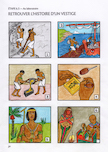
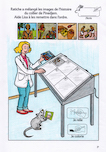 The collar of Pinedjem illustrates “Revealing the History of an Archaeological Find” in pages 30-31 of My Archaeology Book for kids ages 5 to 8. Archaeologists use this as a way to think about an archaeological find to reveal the history of that find, from its making to its destruction or disposal, in order to learn about the lives of the people who made and used it.
The collar of Pinedjem illustrates “Revealing the History of an Archaeological Find” in pages 30-31 of My Archaeology Book for kids ages 5 to 8. Archaeologists use this as a way to think about an archaeological find to reveal the history of that find, from its making to its destruction or disposal, in order to learn about the lives of the people who made and used it. This necklace with floral pendants and a plate bearing the name of Pinedjem I shows the mastery of Egyptian goldsmiths. Made of gold inlaid with lapis lazuli, it is 60 cm (about 24 inches) long and dates from ca. 1050 BCE (21st Dynasty). This necklace is currently held at the Louvre Museum (Inventory Number E 25412), and can be viewed in Room 330 of the Sully wing, showcase 7: Jewelry of the first millennium BCE.
This necklace with floral pendants and a plate bearing the name of Pinedjem I shows the mastery of Egyptian goldsmiths. Made of gold inlaid with lapis lazuli, it is 60 cm (about 24 inches) long and dates from ca. 1050 BCE (21st Dynasty). This necklace is currently held at the Louvre Museum (Inventory Number E 25412), and can be viewed in Room 330 of the Sully wing, showcase 7: Jewelry of the first millennium BCE.
Pinedjem I was the first high priest of Amon at Karnak. Married to a daughter of Pharaoh Ramses XI, Pinedjem enjoyed an eminent position in Upper Egypt, even granting himself the use of the royal naming convention. One of his sons would assume the throne as Psusennes I, succeeding Nesbanebdjed Ist called also Smendes.
In this section, Pinedjem I’s necklace helps us to understand how archaeologists, here represented by archaeologist Lisa, try to reconstruct history from archaeological finds (artifacts and features). In other words, how data are analyzed for a technical reconstruction of each stage of its production or construction, the circumstances in which it was used and how it came to be destroyed or discarded. For this reason, this step is undertaken in a laboratory setting which explains Lisa’s lab coat. The light table, which usually displays photographs of the different elements, is used here to organize alternative hypothetical stages in the crafting processes of the necklace, with the help of the intelligent assistant Ratiche the rat, representing human intelligence.
Clues
The five clues include:
- A light table (with button on the top right and an electric wire), to classify the various images
- Images reconstructing each stage in the life of the necklace of Pinedjem I
- The room where archaeologist Lisa works, indicated by the floorboards
- Lisa's laboratory work clothes (lab coat, with her first name)
- Ratiche the rat
Learn more about this step’s reference artifact in MAB2
 The Great Pyramid of Giza, also known as Khufu's Pyramid in Egypt, illustrates “Revealing the History of an Archaeological Find” in pages 36-37 of My Archaeology Book for kids and teens ages 8 to 16. Archaeologists use this as a way to think about an archaeological find to reveal the history of that find, from its making to its destruction or disposal, in order to learn about the lives of the people who made and used it.
The Great Pyramid of Giza, also known as Khufu's Pyramid in Egypt, illustrates “Revealing the History of an Archaeological Find” in pages 36-37 of My Archaeology Book for kids and teens ages 8 to 16. Archaeologists use this as a way to think about an archaeological find to reveal the history of that find, from its making to its destruction or disposal, in order to learn about the lives of the people who made and used it.
Listed as a World Heritage Site by UNESCO in 1979, along with the necropolis at Memphis, this monument was built by the ancient Egyptians. It forms a pyramid with a square base. Presumed to be the tomb of the Pharaoh Khufu, it was erected during the 4th Dynasty, between 2551 and 2528 BCE, according to Mark Lehner, an American archaeologist. It is centrally positioned in the funerary complex of Khufu, near Giza, close to Cairo, modern Egypt’s capital. At 146 meters (about 480 feet) high, it is Giza’s largest pyramid.
In this section, the Great Pyramid of Giza, or the Khufu's Pyramid, helps us to understand how archaeologists, here represented by archaeologist Lisa, reconstruct history from an archaeological find (artifact or feature). In other words, how data are analyzed for a technical reconstruction of each stage of the object’s production or construction, the circumstances in which it was used and how it came to be destroyed. This is the reason why this step is undertaken in a laboratory setting which explains Lisa’s lab coat. The light table, which usually displays photographs of the different elements, is used here to organize alternative hypothetical stages in the building processes of the pyramid, with the help of intelligent assistants Musculus the mouse and Ratiche the rat, representing human intelligence.
Many theories about how the Great Pyramid was built have been offered successively, from the ideas of Herodotus in the 5th century BCE until 2007, when the retired architect Jean-Pierre Houdin shared his work, focusing not only on how the blocks were transported but also on the whole of the pyramid’s construction site. You can read a summary of his study in English in “Khufu's Pyramid: The “Inside-Out” Construction Theory”. Find additional information in French at www.construire-la-grande-pyramide.org, the website of the Association for Building the Great Pyramid (ACGP, Association Construire la Grande Pyramide) and in English at www.scanpyramids.org for the most recent discoveries and the evolution of Jean-Pierre Houdin’s theory.
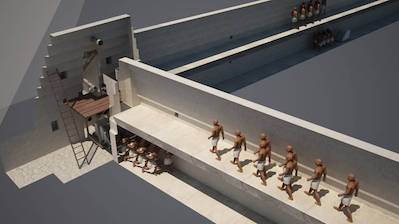 |
Clues
The six clues include:
- A light table (with button on the top right and an electric wire), to classify the various images
- Images reconstructing each stage in the life cycle of the archaeological artifact
- Lisa's laboratory work clothes (lab coat, with her first name)
- Lisa, the archaeologist
- Ratiche, the rat
- Musculus, the mouse
Conducting ExperimentsMy Archaeology Book
Resources HomepageStep 7.1 - Dissemination
Writing up Results
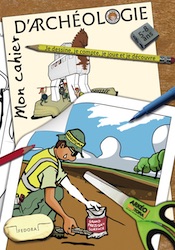 |
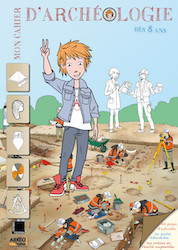 |
|
My Archaeology Book 1 |
My Archaeology Book 2 |
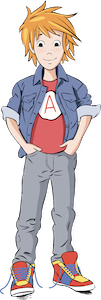
 My Archaeology Book, or MAB, is an activity workbook that combines creativity, fun and learning. Alongside young Augustin, a curious and courageous boy, children meet Alex and Lisa, two friendly archaeologists who will lead them to discover archaeology and French heritage. Each drawing illustrates a situation that Alex and Lisa might encounter at work. Depending on the age of the child and the workbook, children follow easy-to-understand symbols in order to experiment with activities such as coloring, drawing, observation games, riddles and reading in order to see the world through an archaeologist’s eyes. Alone, with family, at school or just for fun, children expand their knowledge and gain skills, all while having fun.
My Archaeology Book, or MAB, is an activity workbook that combines creativity, fun and learning. Alongside young Augustin, a curious and courageous boy, children meet Alex and Lisa, two friendly archaeologists who will lead them to discover archaeology and French heritage. Each drawing illustrates a situation that Alex and Lisa might encounter at work. Depending on the age of the child and the workbook, children follow easy-to-understand symbols in order to experiment with activities such as coloring, drawing, observation games, riddles and reading in order to see the world through an archaeologist’s eyes. Alone, with family, at school or just for fun, children expand their knowledge and gain skills, all while having fun.
On this section, you will find additional resources: color photos of archaeological documents that inspired My Archaeology Book, additional teaching documents (flip-book, websites, suggestions for classroom use, edutainement, etc.) and information on upcoming publications. Each page will be updated over time.






